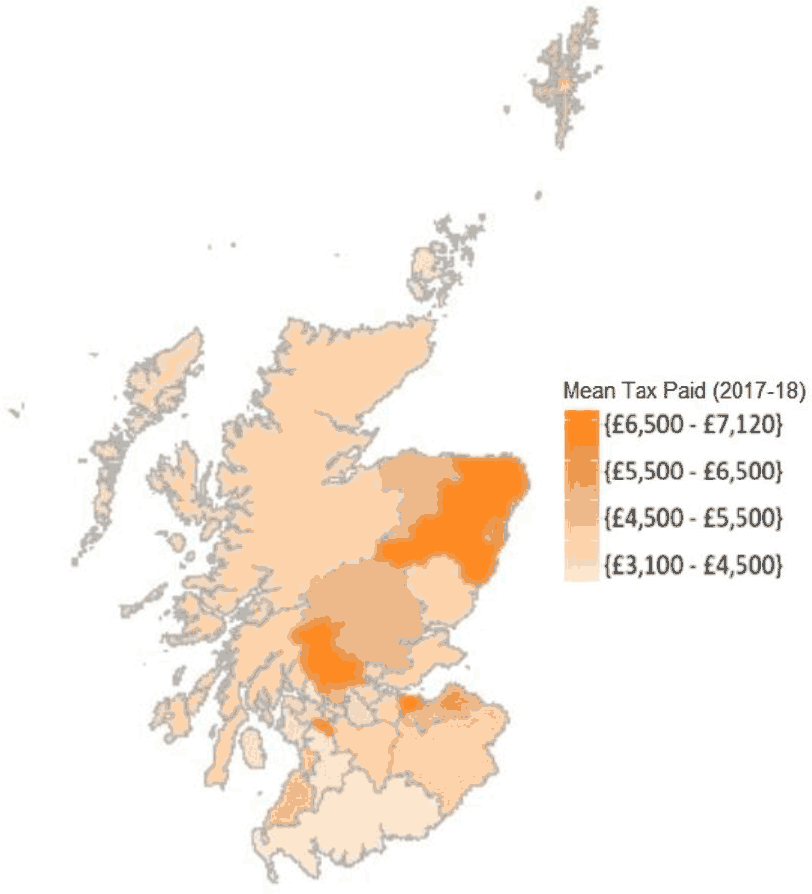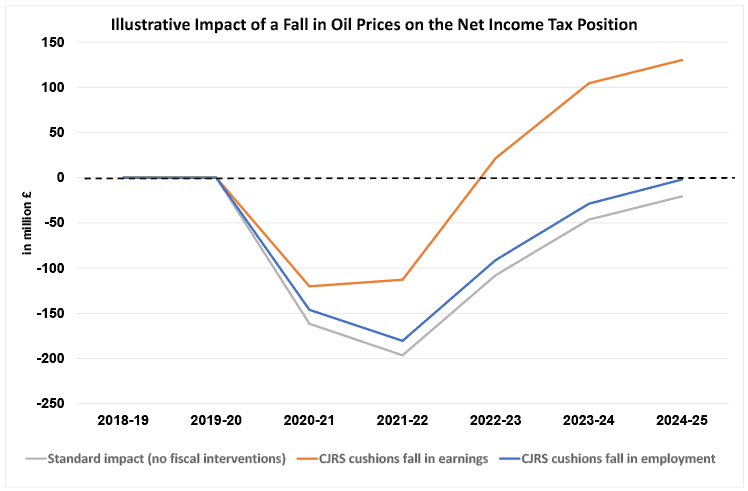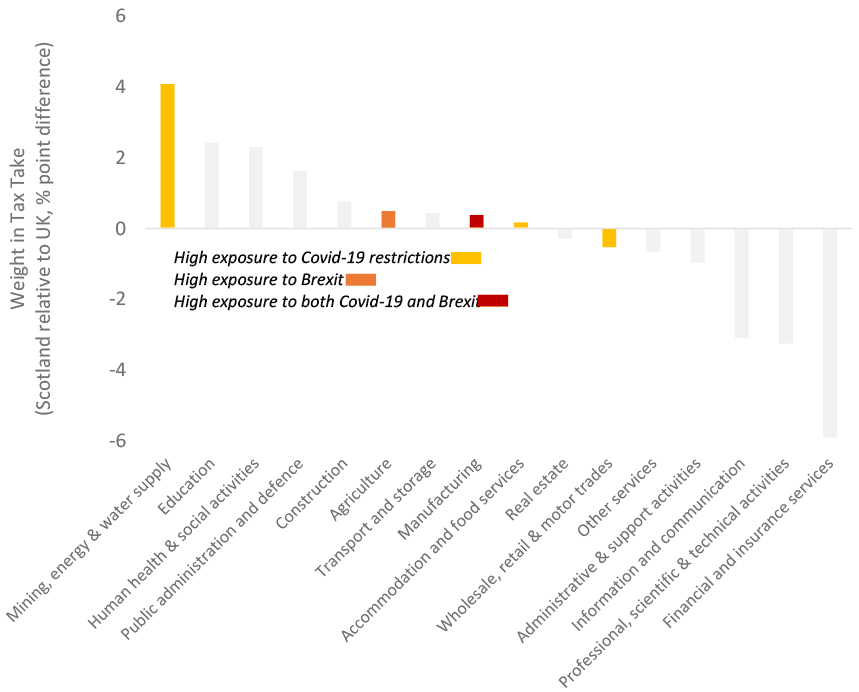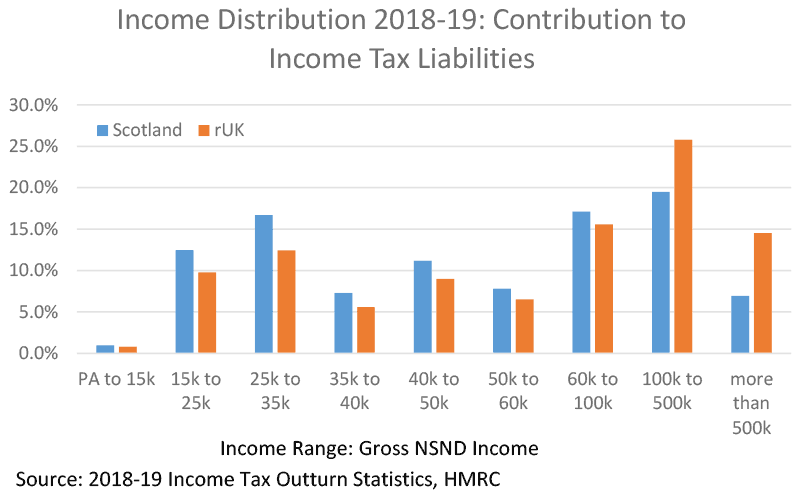Scotland's Fiscal Outlook: The Scottish Government's Medium-Term Financial Strategy
This is the third Medium Term Financial Strategy (MTFS) published by the Scottish Government. The MTFS provides the context for the Scottish Budget and the next Scottish Parliament. This context will frame the incoming Government’s strategic approach to fiscal policy.
This document is part of a collection
Annex B - Risks to Scottish Income Tax receipts
Income Tax devolution is still a relatively new concept and our understanding of Scotland’s historic tax performance is constantly evolving as more evidence becomes available. Income Tax outturn data is only available with a significant lag as the deadline for completing self-assessment returns is 31 January following the tax year. As a result, evidence about Scotland’s trends, relative to the rest of the UK, currently only spans two years, 2017-18 and 2018-19.
Under the Fiscal Framework, Scotland’s budget position improves if tax receipts per head grow more quickly in Scotland than in the rUK (and vice versa). There are a number of factors which can affect Scotland’s relative tax performance, including:
- Growth in earnings, pensions and property income: Growth in wages is one of the key drivers of Income Tax performance.
- Growth in the number of taxpayers: This in turn depends on growth in the (working age) population, the performance of the Scottish labour market as well as decisions around the UK-wide Personal Allowance which may lift some taxpayers out of paying tax altogether. The Fiscal Framework protects Scotland against its relatively slower population growth as it operates on a per head basis.
- Differences in the composition of the tax base, including the relative contribution of high Income taxpayers and their earnings growth.
- Policy changes and resulting changes to taxpayers’ behaviours, including out-migration or a reduction in the number of hours worked.
Scotland’s historic tax performance has been mixed to date. In 2017-18, Scottish receipts per head grew less quickly than in the rUK, resulting in a net loss to the Scottish Budget of -£97 million. Slower growth in incomes, as well as relatively slower growth in the number of taxpayers, explains the large majority of Scotland’s budget shortfall in 2017-18[49]. There is some evidence that this was linked to the downturn in the oil and gas industry and wider North Sea supply chains, which resulted in a loss of high-paying jobs in the Aberdeen area. This was only partly offset by tax raising measures which are estimated to have generated an extra £108 million, compared to a scenario where Scotland had maintained the same rates and bands as the rUK.
Income Tax receipts per head did grow significantly faster in Scotland than in the rUK in 2018-19, resulting in a £119 million net gain to the Scottish Budget. However, this was largely due to Scotland’s Income Tax policy reform. The introduction of the five-band regime is estimated to have raised at least around £300 million, compared to a scenario where Scotland had maintained the same rates and bands as the rUK. We will never know for certain how much the policy changes raised as we are comparing the outturn data against a hypothetical scenario which we will never be able to observe. However, the Scottish Government, in collaboration with HMRC, is looking to publish a more detailed evaluation of the 2018-19 Income Tax reform in the summer of 2021, assessing the scale of the behavioural effects and the amount of revenue raised.
Economic and tax data on the performance of Scotland’s underlying tax base in 2018-19 is only just emerging and the publication of the 2018-19 Survey of Personal Incomes in spring 2021 will shed further light on this issue. There is some evidence, however, that Scotland’s performance may have improved compared to 2017-18, albeit only marginally: the gap in average earnings growth narrowed and GDP growth was broadly similar in both countries in that year. However, should the policy have raised more than £300 million, this would point to continuing weakness in Scotland’s Income Tax base, relative to the rUK’s. This could be due to Scotland’s economic growth being less tax rich, lower employment growth and differences in the composition of the tax base. It is not until 2019-20 that we see a significant improvement in the underlying economic data, in particular on earnings growth, and PAYE liabilities from the real time information (RTI) system.
Under the Fiscal Framework, weaknesses in tax performance can also persist over time, unless a year of relatively weaker tax growth is followed by a strong performance in the following year. In other words, even if tax receipts per head had grown at the exact same rate in both countries in 2018-19, this would only have maintained the -£97 million shortfall which opened up in 2017-18. For this gap to close, Scotland would need a year of significantly faster receipts growth.
Impact of sectoral differences: the importance of Scotland’s oil sector
As noted above, Scotland’s greater exposure to movements in global commodity markets, and in particular the oil price, appears to have been a key driver of Scotland’s relatively weaker Income Tax performance in 2017-18. The steep decline in the global oil price in 2015 and 2016 triggered a significant shock to the Scottish production sector but had a limited impact on the UK as a whole. This resulted in a loss of high paying jobs in the Aberdeen area and in the production sector and depressed earnings growth. As illustrated in Chart B1, there is also a regional dimension to this as Scotland is highly reliant on Income Tax receipts from taxpayers in the Aberdeen area and the two main cities, Edinburgh and Glasgow, which when taken together, including the respective central and immediately surrounding local authorities, account for around 60% of total Income Tax receipts in Scotland (including savings and dividends).

Source: HMRC National Statistic Tables based on the Survey of Personal Incomes (SPI) Statistics 2017-18
As an illustration of the potential downside risks to Scotland’s tax receipts, and drawing on the lessons from 2017-18, we have modelled the potential impact an oil shock could have on the Scottish Budget with the Scottish Government Global Econometric Model (SGGEM) of the Scottish and UK economies. The simulation applies an oil shock (oil price reduction) of a similar magnitude as witnessed during 2020 and the COVID-19 crisis.[50]
The key findings from SGGEM, is that even a relatively temporary oil shock can have quite persistent impacts. Although economic activity does recover quite quickly, the impact on earnings and employment growth can last a few years. Importantly, in the context of the Fiscal Framework, such an oil shock has asymmetric impacts on Scotland and the UK and consequently the net position of devolved tax revenues, most notably LBTT and Income Tax.
In the absence of any policy interventions, it is estimated that the fall in the oil price could reduce Scotland’s Income Tax net position by between -£113 and -£196 million in 2021-22, depending on the cushioning effect of the furlough schemes.
The nominal fall in the Oil price was not as significant or as persistent as that witnessed during 2015-16 and consequently this does not necessarily mean that the impact on receipts will be as severe as shown here. Mainly this is because the oil price fell from a much lower level during 2020 and it is likely that oil producers might already have adjusted their production processes to this lower price environment. Secondly, the UK Government’s furlough schemes might have cushioned the immediate impact.

Looking ahead, there is a considerable risk that the Scottish Income Tax base might prove less resilient to COVID-19 and the UK’s exit from the EU than the rest of the UK’s, simply due to differences in the sectoral composition of the two economies.
In 2017-18, Scotland raised around 22.3% of its total Income Tax take from sectors disproportionately impacted by these shocks, compared to only 17.7% in the rUK. This is largely driven by the Mining & Quarrying sector which accounts for a much larger share of the overall tax take in Scotland than in the rUK. This might be partly offset by Scotland’s relatively greater reliance on the public sector where earnings and employment have held up relatively well, compared to the private sector.
The UK Government’s fiscal measures, including the furlough schemes, have so far masked underlying regional trends. However, as these schemes start to unwind from May 2021, differences are likely to emerge.

Note: A positive figure indicates greater exposure in Scotland.
Impact of differences in the income distribution
In addition to variations in economic growth, significant differences in the distribution of the Income Tax base in Scotland and the rest of the UK also pose a notable risk to the Scottish Budget, albeit to a lesser extent than differences in economic performance. Most importantly, there are relatively fewer high income taxpayers in Scotland than in the rest of the UK and their earnings are also typically lower.
Further analysis of the 2018-19 outturn data, which was published in September 2020, shows that Scotland had relatively more taxpayers in the £15,000 to £40,000 NSND income bracket than the rest of the UK.[51] However, significant differences start to emerge at the higher end of the income distribution. For example, the proportion of taxpayers earning £100,000 or more was considerably higher in the rest of the UK than in Scotland (2.6% vs. 1.7%) whilst incomes per head in that cohort were also 21% higher in the rUK.
As a result, Scotland raised a relatively smaller proportion of liabilities from individuals earning £100,000 or more in 2018-19 (26% vs. 40%).

This means that UK-wide factors that disproportionately affect income at the basic rate, such as the increase in the UK-wide Personal Allowance, will have a relatively greater impact on Scottish liabilities. Under the Fiscal Framework, the reduction in Scottish receipts is partially offset by the reduction in the corresponding block grant adjustment (BGA). However, since the BGA does not account for differences in the income distribution between Scotland and rUK, the change in the BGA understates the reduction in revenues in Scotland when the Personal Allowance increases. This means that the Scottish Budget is made worse off by increases in the Personal Allowance.
For example, Scottish Government analysis suggests that the net position would have improved by around £52 million in 2017-18 and £88 million in 2018-19 if the Personal Allowance had been frozen at its 2016-17 level instead.
UK and Scottish Ministers agree that the impact of Personal Allowance increases on the Scottish Budget should be accounted for, in line with the spillover provision in the current Fiscal Framework Agreement. This states that when either government makes a policy decision that affects the tax receipts or expenditure of the other, the decision-making government should reimburse the other if there is an additional cost, or receive a transfer if there is a saving.
However, UK Ministers believe that only above inflation increases in the Personal Allowance should be accounted for. The Scottish Government believes that all increases in the Personal Allowance should be accounted for, as any increase impacts the Scottish budget. This issue remains unresolved. The Cabinet Secretary for Finance wrote to the Chief Secretary to the Treasury in December 2020 to set out her view on this issue, and to note that it may be necessary to engage the Fiscal Framework’s dispute resolution procedures if agreement could not be reached. Further engagement will take place to resolve this issue as soon as possible.
The Scottish Government position should not be interpreted as implying that the Personal Allowance should not have been increased over time to mirror growth in earnings and maintain households’ spending power. It simply suggests that the flaw in the operation of the Fiscal Framework should be remedied via a spillover claim. The Welsh Fiscal Framework automatically deals with this issue by using a BGA which accounts for the differences in the composition of the tax base. This would be preferable to having to deal with this via a separate spillover claim.
Conversely, UK-wide factors that have a disproportionate impact on the incomes of top earners will have a relatively larger effect on rUK receipts. There is evidence from a range of data sources that earnings growth is unequally distributed across the income distribution as earnings tend to grow more strongly at the bottom and top end of the income spectrum. According to the SFC, individuals at the very top end of the income distribution in the UK (i.e. within the 99th percentile) have seen their incomes grow significantly faster since 2002, compared with Scottish individuals.[52] There can also be significant variation in income growth across deciles in individual years.
Since differences in the composition of the tax base were already evident when Income Tax was devolved and can only be changed very gradually, this issue must be considered as part of the Fiscal Framework review. One option that would address both of the issues set out above would be to mirror the approach in the Welsh Fiscal Framework which creates separate BGAs for each tax band rather than having a single BGA for Income Tax as a whole. Our analysis suggests that, had such a mechanism been in place since 2016-17 and applying the per capita indexation method, the shortfall in the Scottish Budget would have been £145 million lower cumulatively.
| BGA (£ million) | 2016/17 | 2017/18 | 2018/19 |
|---|---|---|---|
| Current Fiscal Framework | 10,719 | 11,013 | 11,437 |
| By Band Indexation (per head) | 10,719 | 10,962 | 11,343 |
| Difference | 0 | -52 | -94 |
Contact
Email: Gabrielle.Cahen@gov.scot
There is a problem
Thanks for your feedback